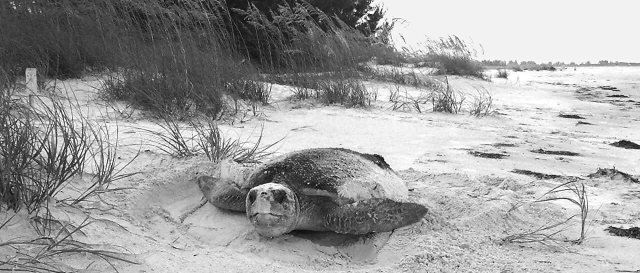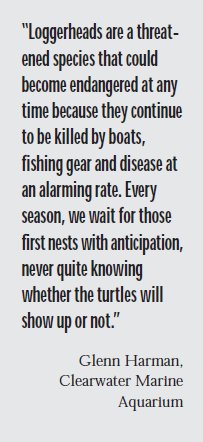By Victoria Parsons
Summer 2004
The sun is just barely peeping over the horizon when Glenn Harman gets to work. Barefoot and wearing shorts and a tee shirt, he climbs on a bright yellow ATV and begins the 30-mile trek he makes seven days a week from May through October.
As director of animal care at Clearwater Marine Aquarium, he’s charged with protecting sea turtle nests on Pinellas County beaches from Caladesi south to Treasure Island. Over a typical season, he and his team will mark about 170 nests – double that for “false crawls” where the female comes ashore but leaves without nesting.
The morning I tagged along, we were lucky. Although this year is shaping up to be less productive than normal for turtles in Pinellas, Harman and assistant Tammy Langer found four nests on the 35 miles of beach they patrol.

“Some years are just better than others,” Harman says. “We’ll have three or four good years and then the number of nests will drop off for no apparent reason.” Last year, CMA logged a record 200 nests, including 70 by mid-June; this year, only 60 females have been successful at laying eggs on the beaches they patrol over the same period.
Zipping over the beach at dawn on his ATV, Harman watches for the tell-tale tracks the turtles leave as they drag bodies that weigh up to 300 pounds across sand with flippers better suited to water than land. Most turtles on Pinellas beaches are loggerheads — the only species of turtles which nests and hatches exclusively at night. Florida, he notes, is the most important loggerhead nesting ground in the world, although many more nest on the east coast than the west.
Early in the morning, the tracks are still clear so it’s critical that they’re marked before beachgoers in the state’s most densely populated county cover their trails. Half curator, half educator, Harman answers questions from passersby as he stakes out the nests. “Most people want to learn more, and want to do their part to protect turtles, but more people need to know that they are a threatened species and what they can do to help.”
Coastal development, of course, has dramatically changed the beaches where sea turtles nest and CMA research is focusing on the potential differences in hatching success on natural beaches and those that have been renourished. Gauges that measure temperature and water levels are placed next to each nest, and data on characteristics such as sand particle size, incubation temperatures, inundation periods and compaction are noted.
 The most immediate problem in Pinellas, however, is artificial lights that confuse hatchlings. In a natural environment, water reflecting moon and stars is brighter than land, and turtle hatchlings use that visual cue to head toward the ocean. Beachfront lights cause them to turn inland where they are likely to die. “We’ve been able to work with some cities and some neighborhoods to reduce artificial lights, but we still cage each nest so that we can make sure the hatchlings get to water,” Harman says.
The most immediate problem in Pinellas, however, is artificial lights that confuse hatchlings. In a natural environment, water reflecting moon and stars is brighter than land, and turtle hatchlings use that visual cue to head toward the ocean. Beachfront lights cause them to turn inland where they are likely to die. “We’ve been able to work with some cities and some neighborhoods to reduce artificial lights, but we still cage each nest so that we can make sure the hatchlings get to water,” Harman says.
Two of the four nests discovered that morning need to be moved, one because it was too close to the water and another was located on a beach scheduled for renourishment later in the summer. On his knees and digging with his hands, Harman carefully removes the eggs from their flask-shaped nests – 131 at an Indian Rocks site and 76 from a nest on Clearwater Beach.
Nests are moved only when necessary because females return to lay eggs on the same beach where they hatched. They may lay eggs several times during a season, but don’t breed every year.
South Florida populations of sea turtles appear to be stable but it’s difficult to track long-term trends in animals that may live to be up to 50 years old. Little is known about their life cycles but the Atlantic loggerhead can be found in coastal waters of the Gulf of Mexico and the Atlantic Seaboard from the Florida Keys as far north as New England.
Adults have few predators beyond sharks, but shrimp nets and boat strikes kill up to 100 adults in Florida waters annually. Other turtles can die or be severely injured by monofilament fishing line. “Loggerheads are a threatened species that could become endangered at any time because they continue to be killed by boats, fishing gear and disease at an alarming rate,” Harman said. “Every season, we wait for those first nests with anticipation, never quite knowing whether the turtles will show up or not.”
Manatee County Counts on Volunteers
Across the state, beaches are monitored by individuals or organizations called Marine Turtle Permit Holders who are responsible for a specific stretch of beach. Manatee County depends on volunteers to patrol its beaches, including 130 people who participate in the Anna Maria Island Turtle Watch.
Unlike most of Florida, Anna Maria is home to an active group of turtles who nest bayside rather than directly on the Gulf or ocean, notes Suzi Fox, volunteer director of the sea turtle program. “We get calls from all over the country from researchers – there are only two other bayside nesting sites in the country.”

Beginning about 6 a.m., volunteers from as far away as Ruskin are on the beach looking for distinctive sea turtle tracks. “We have every inch of nesting beach monitored by 7:30 a.m.,” Fox notes. She’ll have a complete list of which species came ashore, whether the female was successful or made a false crawl, and whether the nest needs to be moved because it’s too close to the water.
Help from three municipalities and Florida Power & Light means that Fox and her volunteers don’t need to cage nests the way CMA must. “In the mid-‘90s we caged about half our nests, but they have to be watched all night and it’s really rough on volunteers who have to stay up and then go to work in the morning,” she said.
Don Sayre of FP&L found a “cobra-head” light fixture that throws the light directly on the ground at a price the cities could afford, Fox notes. “They’re not perfect but they’re a heck of a lot better than what we had,” she said. FP&L also brought out a cherry picker to align each and every one of the lights so it faced away from the beach as much as possible. “They were in a truck and we had volunteers on the ground with radios all night long,” she said.
With street lights minimized, the biggest challenge is now light flooding from homes, but the cities have adopted regulations that call for minimum light during nesting season and have enforcers who explain to residents why it’s important.
“We’re making great strides every year,” Fox said. “And we just got a grant from the sea turtle license plate that will cover the cost of 6000 pieces of material we can pass out, plus little stickers that go near windows reminding beach-front residents that turning on a light can harm sea turtles.”